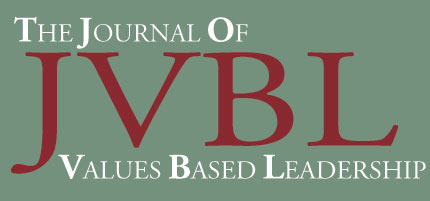- CONTENTS:
- Table of ContentsLetter from the EditorSustainability and the Bottom Line: The Responsible Collusion of Economics, Social Responsibility, and the EnvironmentProgress Toward Zero: The Climb to SustainabilityPlant Tour and Meeting with Members of Interface's Sustainability Team: December 16, 2009Driving Sustainable Innovation: A Pioneer for the 21st CenturySucceeding Through Collaborative Conflict: The Paradoxical Lessons of Shared LeadershipClimate 2030: A National Blueprint for a Clean Energy EconomySpiritual Enterprise: Doing Virtuous Business
- PROGRESS TOWARD ZERO: THE CLIMB TO SUSTAINABILITY

Source: http://www.interfaceglobal.com/Sustainability/Progress-to-Zero.aspx
Marker 1: Interface cut waste sent to landfills by more than two-thirds while continuing to increase production.
Marker 2: Approximately $405 million in cumulative avoided waste cost from 1995 to 2008.
Marker 3: Interface diverted over 100 million pounds of materials from landfills.
Marker 4: Interface reduced net greenhouse gas emissions by more than 71% through efficiency, process changes, and purchasing renewable energy and offsets.
Marker 5: Interface has sold more than 83 million square yards of its climate neutral carpet product.
Marker 6: Eight of Interface’s ten facilities operate with 100% renewable electricity.
Marker 7: Through the implementation of energy efficiency projects and changes in manufacturing processes, Interface has reduced the total energy intensity by 44% since 1996.
Marker 8: Water intake per unit of production in modular carpet manufacturing facilities is down 74% from 1996 levels.
Marker 9: Over 24% of raw materials used in Interface carpet are recycled and bio-based materials in 2008.
Marker 10: Since 1997, Interface has planted almost 98 thousand trees to reduce the impact of 191 million business-related air miles and over 10 thousand trees for the Cool CO2mmute program.
Marker 11: Interface contributed in excess of $750,000 to external organizations in 2008.
Marker 12: Interface associates volunteered more than 15,000 hours in community activities in 2008.
Marker 13: Interface associates have delivered sustainability-related educational speeches to millions of stakeholders.
“If that product cannot be made susttainable, we have no business making that product. For that matter, neither does anyone else.”
- Ray C. AndersonBackground
The JVBL editorial staff had the good fortune to interview Mr. Anderson on November 22, 2008, to discover the current status of Interface’s quest for zero emissions in 2020 and to uncover the sources of one person’s motivation, persistence, energy, and dedication in restructuring an already profitable enterprise. The interview was followed by an on-site visit of Interface’s warehouses, factories, and main headquarters in and around the Atlanta, GA metropolitan area in mid-December, 2008.
Interview, November 22, 2008
Q: Mr. Anderson, you are truly a pioneer and innovator and the Interface model appears to be the proverbial pebble in the pond producing a worldwide ripple effect in the retooling of commerce and industry. Speaking personally, I truly believe that it only takes one person to affect substantial change for the betterment of the world.
In the mid-1990s, you formulated the seven stages of sustainability for Interface and projected zero emissions by 2020. Your company’s most recent programs demonstrate a succession of eco-friendly, innovative practices, including the “Evergreen Lease” program, the new Flor Products, and the trademarked Bentley-Prince innovations. With your 2020 goal of complete sustainability, where is Interface presently?
The different metrics of Interface that you mentioned are very different, sort of like peaches and tomatoes, but when you put it all together, we are somewhere more than half-way, I think. For example, with respect to our green house gas emissions, we are down a net of 83% in greenhouse gas intensity relative to sales.
Q: So have you approached the restorative process yet?
We are not counting renewable energy credits, not yet, but if we were, we would be at 99%. With offsets, we are creating climate-neutral products.renewable energy credits, not yet, but if we were, we would be at 115%. With our offsets, we are creating climate-neutral products.
Q: Unlike companies that only measure their environmental successes by evaluating activities at just 1 stage — for example, manufacturing, assembly, distribution, Global Reporting Initiative, a United Nations world protocol voluntary reporting system based in Amsterdam, reviews a wider array of factors: environmental, social, and fiscal. So when we assess the activities of your vendors, your transporters, and other third parties, working on your behalf but outside the factory proper, where would you slot Interface in your sustainability summit?
The reduction in greenhouse gases is 71% in absolute tonnage. Interface is two-thirds larger over the same span of time, from 1996-2008. So 71% really translates into 82 or 83% in reduction of carbon intensity. With respect to the water usage, we’re at negative 74 - that number has changed a little bit from the previously reported figure of -80. The material diverted from landfills is now 175 million pounds, 87,500 tons. The fossil energy consumption is down 60% per unit of production and renewable energy is now at 28% of total. And renewable materials — that includes both recycled and bio-based — is somewhere north of 24% has been increasing rapidly. With respect to a couple other metrics, we’ve shut down a third of our smokestacks — essentially obviated them — and 71% of our effluent pipes have been abandoned, obviated by process changes.
Q: What types of process changes allow you to eliminate these things?
We’ve significantly eliminated wet processing — the liquid effluent. Waste reduction amounts to about 50% working against our definition of perfection.
Q: Has the Evergreen Lease Program been successful?
Actually, this is not a new venture — this is one of the first things we did, but it was way ahead of its time. And in fact the economics don’t yet quite favor it, but it might just come around. As the size of recycled content increases and the price of virgin material go up, the advantage is to lease. But we’re not there yet. So the lease has had very limited success. As we are getting into the $140 - $150 range for oil, we were on the verge of reviving the Evergreen Lease. But now that oil prices have dropped back…we will just wait and see.
Q: In terms of recycling, when you receive calls from various businesses who are either remodeling or leveling buildings containing Interface-made carpet, what factors will influence your decision to retrieve this material?
We are in the market right now for recycled material. We are taking back not only our old products, but our competitors’ old products and those of non-competitors.
Q: With respect to your recycling program, do you draw the line as to how many businesses act as participants in this program? Is there a limit on quantity that Interface can handle?
We focus on the commercial and institutional end rather than residential. It’s probably not feasible unless you have a dealer who is willing to accumulate carpet from a lot of houses with carpet that needs to be taken up all to be sent back at once. We tend to deal with larger installations, commercial and institutional. Essentially, this is our Entry 2.0 program; it is our reverse logistics effort to get the stuff back. And we are in the market for it. The most recent technical breakthrough we’ve made is in working out the recycling of the nylon face. We had to send it back into the market for such usage as engineered plastics but now we’re actually getting it back into the fabric and from the fabric back into products. We have closed the loop on nylon now which is a big breakthrough. Over 24% of our raw material is recycled or bio-based and that figure is increasing rapidly. The “increasingly rapidly” aspect of that is coming from the nylon side.
Q: Do you have somewhat of a mixed view on the price of gasoline prices and petroleum products going down, maybe it’s a temporary decrease, but it seems like there is a corollary of people’s perceptions and recycling, thinking about what they’re doing and the price of gas, because all of a sudden everyone’s hopping in their cars once again. I was happy to see my students walking and riding bikes, sloughing cars, but I was wondering with your industry at such a higher level, if you were seeing an actual reduction in the number of contacts or calls you’ve been receiving as to recyclable products because they just feel that gas is going down, oil is going down, or are these programs steady? Are these ideas taking root and growing, regardless of the economy?
The price of virgin materials in the long run has to go up. So the relative advantage of recycled material will increase over time, and today we see this as a competitive advantage, actually the higher the cost of oil goes, and the higher the cost of virgin materials, the greater our relative advantage. We are quite sanguine with $140 a barrel, and looking for it to go to $200.
Q: When I peruse the resources available on the Mission Zero website, your pledge of complete sustainability for Interface by 2020, and the warnings of Paul Hawkin’s “The Ecology of Commerce” regarding extinction of species and compromised eco-systems, I have doubts that meaningful change required to reverse global climate is within reach. And knowing ― according to the most recent statistics ― that while the United States comprises 5% of the world’s population but uses 25% of the world’s non-renewable sources of energy, it would seemingly appear that meaningful change is not within our grasp. We have all had it very easy and acclimated to a rather comfortable lifestyle. Do you really believe that it’s possible to “unspoil the child” in time?
I think that the mind shift has already begun and like Deepak Chopra says, everyone’s doing the best they can given their level of awareness. It’s all about changing the level of awareness and that is happening. The spiking oil prices pushed that along. For the people who will relapse into old ways, I don’t know. If they do, I think it’s short-lived because I think we’re past it.
Q: There is some angst generated when “people lapse into their own ways.” Just to give you an idea of what is happening in our neck of the woods ― just south of Chicago, directly downwind from the steel mills. Recent news about the mills has been bittersweet. With the recent economic downturn, it appears that more than 3000 people will be laid off in the near future. Obviously, that’s horrible news for the workers, their families, and for the local economy. But this type of economic pressure forces companies into a position where to remain viable, they must retool. The same situation is also occurring with the automobile manufacturers. Restructuring in that industry appears more feasible, as nearly every company has devised an electric vehicle in the past. The EV was shelved in California in the early 90s, even though consumer demand was high. Theories regarding this business decision largely point to the pressure from the oil companies and from the auto parts industry. So when it comes to steel and automobile manufacturers, do you believe it is possible to do there what you’re doing with Interface?
Well, with the general model that we published in “Mid-Course Correction,” the transformation from the typical company of the 20th century to the prototypical sustainable company of the 21st century should be possible for all industry.
Q: So you believe it’s uniformly applicable then?
I think it is and of course the specifics will vary from one company to another and from one industry to another. The fundamentals are pretty sound; we all profit by taking stuff from the earth and making stuff that very quickly ends up as waste that ends up in a landfill. Even if it is a car that lasts for twenty years, it ends up as scrap where all cars go to die and all of us are running processes with energy coming from fossil fuels, wasteful and abusive, so I think yeah, the principles apply, and the most important principle of all is in the sixth face of mountain, which calls for the culture shift which may set the manner of change. I think it’s the general model for the whole economy.
Q: And with that particular stage, society might be able to rewrite the chapter in the Ecology of Commerce from “Death to Birth” to “Cradle to Cradle?”
Actually, the “Cradle to Cradle” phrase is William McDonough’s phrase and I prefer not to use it. I prefer to use “Life after Life.”
Q: With respect to changing the mindset, do you believe that the sensitive matter of overpopulation should be addressed as well?
Ultimately, yes. The population growth right now is in the low-impact countries, the developing countries where the average person has very little impact on the environment. It rose for Americans because of the way we live. But if their standard of living rises, then their impact will rise and ultimately the population part of the impact equation: the IPAT. Do you know the IPAT equation?
Q: Where I = P x A x T? Population (P), Affluence (A) and Technology (T) are essentially measured with respect to environmental Impact (I) or resource depletion?
Yeah, I have a vision for the equation. In Mid-Course Correction, I talked about moving technology from the numerator to the denominator, because I = P x (A/T) instead of I= P x (A x T) would reduce impact. But there are a couple things that stand out as being wrong with the IPAT equation even with T in the denominator. One being that “A” suggests Affluence is an end in itself, and I would prefer to see it as a means to an end, so use a “lower case a” to signify a means to an end, and I would like to add an item to the denominator, the end itself: “H” for happiness. So we’re talking about more happiness and less stuff. You’re talking about a real culture shift for more people to be happy with less stuff.
Q: Exactly. And that’s why I think it’s so critical to implement sustainability as an integral part of teaching at least at the business school level. That’s why we created new courses focusing on sustainability and on environmental stewardship. That’s why we’ve elected to publish this Journal of Values Based Leadership. It’s just so critical. It seems to me in terms of the interviews that I’ve done, there are common life experiences which help produce our present-day movers and shakers. During stage 1 – referring to the upbringing of the person, there may have been a religious, social, or personal factor of particular significance that influenced that person in a positive way. That upbringing might have been permeated by acts of benevolence, generosity, and respect for others practiced by parents, siblings or family friends. In early adulthood – the second stage - the individual has an epiphinal experience of some kind. Yours is well documented with the reading of the Hawkin’s book. And the third stage refers to the development and growth of a work ethic, ultimately translated into a passion to better the world. Do you see yourself in that paradigm?
More or less I would say. I have difficulty finding the seed from my childhood that has grown into what I am doing today. I do have classmates I grew up with who say “Ray, you knew life was serious long before the rest of us did.” I don’t know where that came from; I guess being born into a family that didn’t have a lot. My father had a job in the post office coming out of the Depression. I didn’t know we were poor, but we were. I had a mother who made sure I paid attention to my books and studies – a retired teacher I guess who practiced her profession on her children. I don’t know about my childhood seeds that sprouted into my adulthood, but I know the sense of responsibility for future generations, particularly my own grandchildren, plays a big role in it.
Q: This sense of responsibility is insatiable once the awareness is there. It just permeates the being; you wake up in the morning and it’s “I’ve got another day to do something about this,” and I don’t know if that’s your feeling…
Yes, I would think that everyone involved in the movement feels that way … that time is short and the cause is urgent, and we may lose it. But the encouraging thing, the other side of that, is that I’ve never met an “ex-environmentalist.”
Q: It’s something you don’t abandon…
No, once you get it, you don’t “un-get” it. And then there’s one more of us and one less of them. It only moves in one direction.
Q: People say guilt is bad, be it “Jewish Guilt,” “Lutheran Guilt,” “Catholic Guilt,”… any guilt quite frankly, but I see guilt as a good thing at times. With the environmental movement, certainly guilt emanating from examining one’s lifestyle and the resulting acts of environmental degradation committed in support of that lifestyle - whether committed intentionally or not - could be a catalyst for a change of mindset and lifestyle in itself. Do you feel the same way?
I think that’s true, my epiphinal experience came with tears of remorse.
Q: You see that in your videos, especially when you describe yourself as a “thief” and a “plunderer.” We all share these titles. And once our mindsets are altered and our pattern of conduct comports with this new thinking, we must lead by example and surely you have done that – and continue to do that – very well and effectively.
There comes a point where you have to show people the “real deal.” Well, we have the “real deal.” Come to our factory and see it in action. That’s where we kind of “interface,” if you will, with people in a similar line of consulting. They have all the concepts, but they don’t have all the examples, the kind of hands-on examples we have.
Q: In leading by example, colleges and universities have the ability to reform their campuses in line with sound environmental practices under the guidelines provided by A.A.S.H.E. (Association for the Advancement of Sustainability in Higher Education). In conformity with international sustainability conferences in which you direct or participate, aimed for an audience of corporate directors and CEOs, AASHE promotes similar conferences for academe. Valparaiso University is tentatively developing a conference with respect to sustainability that is directly aimed at the business student. While I know your schedule is completely tight, if this event does become a reality, would you ever consider coming up to speak?
You put a conference together, and my schedule fits, you’ve got me.
Q: I will definitely take you up on that. Now…where do you stand with your new book which further chronicles Interface’s quest for Zero Missions?
It’s in the publisher’s hands.
Q: The title is?
It is going to be called “Confessions of a Radical Industrialist.”
Q: My colleague, in fact, has written an article and shot a documentary with respect to the sustainability practices of Subaru, entitled “Green is Free.”
Just for your information, if you don’t know, Subaru and Interface have connected. They have agreed to create offsets upfront so that any of their cars that we drive in our fleet are climate neutral from day one.
Q: When did you start with this program?
It’s about a year old.
Q: Is it taking off?
I have not monitored it myself. People are not required to drive this car or that car, but it’s on a list of approved cars that they can drive. I think for most people who are environmentally sensitive, they’ve gone that way.
Q: That’s fantastic. I see that Paul Hawkins is part of your “Dream Team.” How is that going?
Well, the Dream Team has been critical to us from the very beginning. It was 13 years ago that they helped us get our map straight - the “How do you climb this mountain?” So they’ve been invaluable advisors to us all through the years. What you find is that instead of bringing them together, we go to them individually with specific issues.
Q: With the Interface model being a type of paradigm for all industry, instead of industry coming to you, have you been proactive, let’s say with the steel and the auto manufacturers?
We never go where we’re not invited, but we have an awful lot of good PR.
Q: Recently watching the three auto-makers’ CEOs fly their corporate jets to Washington D.C. … there seems to be some lasting ignorance.
We didn’t hesitate to rub their noses in it.
Q: They seemed unabashedly unashamed. That situation – where, unfortunately, the temporary cessation of employment in Detroit might be necessary for comprehensive re-tooling - is somewhat analogous to the time when Apartheid was at its height in South Africa. There was a worldwide call for boycotting diamonds but the concern was that so many South African mine workers would be out of a job. The consensus, however, from the workers themselves was: “Let us be laid off. This is a worldwide problem that has to be addressed and targeted, and even though we bear the brunt of it, in the end good things will come for all.”
That’s very farsighted, I mean, I mean for people to take that self-sacrificing stance for the greater good…
Q: You saw that in South Africa. I don’t know if you’ll see that so much with our steel workers and auto workers. They and we have all been used to a certain lifestyle. So what might be bare bones existence for us may be living in palatial
The urgency is upon us …
Plant Tour and Meeting with Members of Interface’s Sustainability Team: December 16, 2009
Visiting Sustainability Team Members at Interface Plants in West Point and LaGrange, Georgia
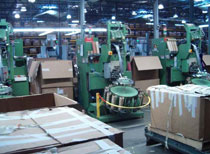 Interface’s Unique Operations
Interface’s Unique OperationsGeorgia, several of its plants are situate just south of the city in the smaller towns of LaGrange and West Point. There are ten primary factories worldwide, with over 3,000 employees and a cumulative three million square feet of manufacturing and warehouse space. As an integral part in manufacturing its flooring products, Interface is striving to achieve a zero carbon footprint from the time an Interface employee leaves for work to the final distribution point of the product — all by 2020.
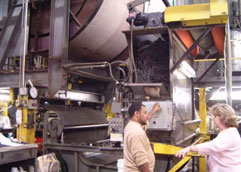
Marketing and Production
Upon entering the primary assembly plant, there is a sense of spaciousness, unlike the anticipated smells and sounds of the manufacturing process. Surprisingly lacking are noxious fumes and the roar of the typical assembly line. The workplace is clean and well organized, lit by natural light emanating through open ceiling panels. Air is circulated by large ceiling fans. The workers, or “associates,” are surprisingly cheery, exhibiting a teamwork-like attitude, knowing that in their production of eco-friendly products, they are setting an example of how other businesses might also produce goods sustainably.
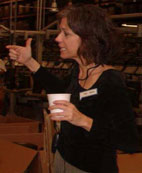 Led into a glassed-partitioned conference room, our JVBL team was introduced to the company’s most recent innovations. One of the company’s marketers demonstrated how the tiles are now being constructed to resist curling, constriction, and contraction to remain stable in different climate zones and under different humidity conditions. The company has also recently eliminated the use of glue in both the installation of the product as well as in fusing the nylon fibers to the tile backing in the production process. This program is known as I’m Off Glue™. To demonstrate these capabilities, several tiles were positioned together, flat on a tabletop. Using a hook mounted in the middle of one of the tiles, it was virtually impossible to lift the tile vertically. This adherence was accomplished through a natural vacuum or suction.
Led into a glassed-partitioned conference room, our JVBL team was introduced to the company’s most recent innovations. One of the company’s marketers demonstrated how the tiles are now being constructed to resist curling, constriction, and contraction to remain stable in different climate zones and under different humidity conditions. The company has also recently eliminated the use of glue in both the installation of the product as well as in fusing the nylon fibers to the tile backing in the production process. This program is known as I’m Off Glue™. To demonstrate these capabilities, several tiles were positioned together, flat on a tabletop. Using a hook mounted in the middle of one of the tiles, it was virtually impossible to lift the tile vertically. This adherence was accomplished through a natural vacuum or suction.To reduce the amount of carpet replaced in worn or high traffic areas in a customer’s workplace, random patterns are being introduced to blend easily with the remaining carpet tiles. In this manner, the tiles can be installed in any direction to produce a blended match without the need to replace the entire floor covering.
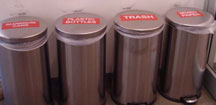 Evidence of environmental awareness is evident throughout Interface’s buildings. Even in conference areas, the associates routinely practice resource reduction, reuse, and recycling. During company meetings, no chalk or dry erase boards are used – rather, a scroll of paper is the medium of choice to illustrate ideas. Once the scroll is completely used, it is reversed, used again, and ultimately recycled. Plastic water bottles have been replaced by plant-based containers. All refuse accumulated in the course of a workday is segregated for recycling.
Evidence of environmental awareness is evident throughout Interface’s buildings. Even in conference areas, the associates routinely practice resource reduction, reuse, and recycling. During company meetings, no chalk or dry erase boards are used – rather, a scroll of paper is the medium of choice to illustrate ideas. Once the scroll is completely used, it is reversed, used again, and ultimately recycled. Plastic water bottles have been replaced by plant-based containers. All refuse accumulated in the course of a workday is segregated for recycling.Due to its commitment to zero waste, and considering its power and position of influence in the global marketplace, Interface can select its suppliers, vendors, and distributors according to their commitment to shared environmental objectives. For example, the shiny substance covering the back of each tile is no longer coated with a polymer-based plastic but has been substituted for a product, referred to as polylactide or “PLA” — a biodegradable polymer — which is essentially a corn-based product made by Cargill. This product has the diaphanous and durability characteristics of plastic without its detrimental environmental consequences. Even everyday transportation is part of the sustainability equation. The company vehicle is a Subaru™ – another company committed to zero waste and landfill. Area restaurants and caterers know that their services will not be needed by Interface without their firm commitment to discontinuing the use of Styrofoam – a non-biodegradable substance often used in the production of disposable containers and cups.
 When the company faces a new challenge or desires to ameliorate a certain deleterious practice, members of the Interface research and development team turn to nature, employing the practice of “biomimycry.” When extra adhesion was needed to anchor adjoining corners of tiles, studies were made using relevant plants, animals, and processes found in nature. The company, after studying the adherence characteristics of the spider, the fly, and the gecko, created a similar substance from natural elements to produce a TacTile™. The TacTile™ is a 4” x 4” clear sheet of PLA lined on one side with the
When the company faces a new challenge or desires to ameliorate a certain deleterious practice, members of the Interface research and development team turn to nature, employing the practice of “biomimycry.” When extra adhesion was needed to anchor adjoining corners of tiles, studies were made using relevant plants, animals, and processes found in nature. The company, after studying the adherence characteristics of the spider, the fly, and the gecko, created a similar substance from natural elements to produce a TacTile™. The TacTile™ is a 4” x 4” clear sheet of PLA lined on one side with the
biologically-duplicated adhering substance. Resembling a clear Post-It™ note, the individual sheet is then positioned beneath the adjoining corners to create a firm hold with a side-pull adhesion quality. Tiles cannot be pulled apart, but can be lifted on the corners to be replaced.Tied into the initial demonstration and marketing area is the production floor. No protective equipment was necessary to enter and explore and no parts of the assembly line floor were “off limits.” The workers were very friendly and willing to explain their respective duties with enthusiasm and pride when queried. None of the forklifts used by the workers in the production area were fueled by diesel or gas; rather, they operated on batteries which are continuously re-charged.
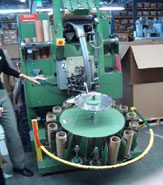 During the early years of Interface, production methods employed the use of over 1000 needles, with individual threads flowing through each, often tangling or breaking before the fibers were fully tufted to complete the product. In cases where individual threads became tangled, or a needle snapped, or a fiber broke, or a new pattern began, the partial product or accumulation of waste materials would usually be discarded in a nearby landfill. Now, the flow of fibers is guided by individual flexible tubes to reduce entanglement and breaks. This practice withdrew a significant portion of the over 5 billion pounds of carpet scrap dumped in U.S. landfills annually.
During the early years of Interface, production methods employed the use of over 1000 needles, with individual threads flowing through each, often tangling or breaking before the fibers were fully tufted to complete the product. In cases where individual threads became tangled, or a needle snapped, or a fiber broke, or a new pattern began, the partial product or accumulation of waste materials would usually be discarded in a nearby landfill. Now, the flow of fibers is guided by individual flexible tubes to reduce entanglement and breaks. This practice withdrew a significant portion of the over 5 billion pounds of carpet scrap dumped in U.S. landfills annually.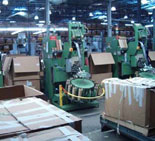 Now broken threads of the same color are easily fused back together. The ends are rejoined by overlapping two strands of like color by approximately ten inches, and a machine customized by Interface interjects air into the overlapped threads, causing them to intertwine. This is just one example of how all previous wasted materials are now reused to create a new floor cover product. Another sustainable practice is exemplified by the construction material of the storage modules. Supplies throughout the warehouses are stored and moved around to different parts of the plant in cardboard boxes which are repeatedly used until the point of disintegration. Even the masking tape used to bind the boxes is made locally from biodegradable materials.
Now broken threads of the same color are easily fused back together. The ends are rejoined by overlapping two strands of like color by approximately ten inches, and a machine customized by Interface interjects air into the overlapped threads, causing them to intertwine. This is just one example of how all previous wasted materials are now reused to create a new floor cover product. Another sustainable practice is exemplified by the construction material of the storage modules. Supplies throughout the warehouses are stored and moved around to different parts of the plant in cardboard boxes which are repeatedly used until the point of disintegration. Even the masking tape used to bind the boxes is made locally from biodegradable materials.Sales and Distribution
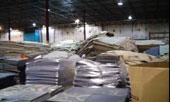 Following the initial tour of the factory floor, a brief meeting was held in the local headquarters and the tour continued to an adjoining warehouse where Interface’s new program, ReEntry™ had been recently launched. In addition to eliminating waste in the production process, the ReEntry™ program recycles used flooring covers – originally manufactured by Interface as well as by other carpet makers. Drivers haul in used carpeting that would otherwise be dumped in landfills. It is cheaper for the drivers to unload these unwanted products in this manner. While the main intake center is located in LaGrange, Georgia, Interface is in the process of locating additional sites throughout the country to reduce the distance to haul and deliver used carpeting. The company ultimately wants to establish regional reception centers — all within 100 miles of each other — and to employ local workers at those new facilities.
Following the initial tour of the factory floor, a brief meeting was held in the local headquarters and the tour continued to an adjoining warehouse where Interface’s new program, ReEntry™ had been recently launched. In addition to eliminating waste in the production process, the ReEntry™ program recycles used flooring covers – originally manufactured by Interface as well as by other carpet makers. Drivers haul in used carpeting that would otherwise be dumped in landfills. It is cheaper for the drivers to unload these unwanted products in this manner. While the main intake center is located in LaGrange, Georgia, Interface is in the process of locating additional sites throughout the country to reduce the distance to haul and deliver used carpeting. The company ultimately wants to establish regional reception centers — all within 100 miles of each other — and to employ local workers at those new facilities.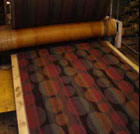 Multiple programs and products are currently in place or under development. The Evergreen Lease® program is a way for institutions — e.g., schools, nursing homes, hospitals, airports, hotels, libraries, convention centers — to install carpeting without purchasing, installing, maintaining, and ultimately discarding the product. With the leasing arrangement, Interface supplies the carpet, keeps it clean, and removes it when the lessor decides to remodel or raze the premises. This program presents a win-win situation: the lessor saves resources and time by having the work done by the manufacturer and Interface can insure that the final discarded product is properly recycled.
Multiple programs and products are currently in place or under development. The Evergreen Lease® program is a way for institutions — e.g., schools, nursing homes, hospitals, airports, hotels, libraries, convention centers — to install carpeting without purchasing, installing, maintaining, and ultimately discarding the product. With the leasing arrangement, Interface supplies the carpet, keeps it clean, and removes it when the lessor decides to remodel or raze the premises. This program presents a win-win situation: the lessor saves resources and time by having the work done by the manufacturer and Interface can insure that the final discarded product is properly recycled.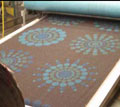 New products are being manufactured under the Bentley Prince Street™ line which blends aesthetics with ecological responsibility. Modular carpet tiles are produced under the InterfaceFLOR™ lines (Americas, Europe, Asia) which provide a plethora of designs in the workplace while remaining true to the company’s Zero Mission.™
New products are being manufactured under the Bentley Prince Street™ line which blends aesthetics with ecological responsibility. Modular carpet tiles are produced under the InterfaceFLOR™ lines (Americas, Europe, Asia) which provide a plethora of designs in the workplace while remaining true to the company’s Zero Mission.™Research and Development
Simply stated, members of Interface’s Research and Development team are driven by one principle: merge brain power with common sense. While government regulations are not spurned in the creation of new products and processes, tax credits for new, cleaner, and ecologically sustainable products and offsetting practices are preferred. Interface’s R & D Department is characterized by numerous professions, ranging from the nannomicrobiologist to the mechanical engineer. Several R & D associates have even come up through the ranks without any specialized degrees or training and have proven themselves to be invaluable team members.
ReEntry™, Recycling and Renewal
Re-Entry™ is currently run as a separate entity. The program receives all used carpeting – tiles and broadloom. Carpet dealers can dispose the used articles at Interface without incurring a higher landfill cost. These independent dealers do bear the cost of transportation and Interface is currently striving to open additional warehouses nationwide to serve as central drop off locations.
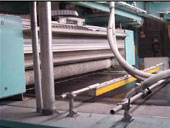 Before the used goods are broken down and reprocessed, those samples deemed to be in substantially good shape are donated to non-profit organizations. Multi-million dollar, customized machines, then begin the process of segregating the different layers of the carpet remnant. Nothing is wasted throughout the process. Since this carpeting has been discarded primarily due to wear and tear and the consequences of high traffic over time, the accumulated dirt is shaken loose. Interface even has a market for the collection and reuse of the accumulated dirt.
Before the used goods are broken down and reprocessed, those samples deemed to be in substantially good shape are donated to non-profit organizations. Multi-million dollar, customized machines, then begin the process of segregating the different layers of the carpet remnant. Nothing is wasted throughout the process. Since this carpeting has been discarded primarily due to wear and tear and the consequences of high traffic over time, the accumulated dirt is shaken loose. Interface even has a market for the collection and reuse of the accumulated dirt.Next, the top fibers are sheered, separated, and formed into new threads. All polymer-based nylon fibers are extracted from the backing which end product is then used at other businesses to produce such parts as vehicle dashboards. The residue is shaped into small, round balls or crumbs, known as “Cool Blue Food™” — harmless to the human system as the new substance lacks toxins, metals, and nonorganic flame retardants.
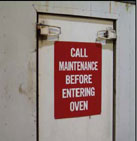 The crumbs are then sent to an adjoining plant to be further purified and cleaned. During the process of merging the backing with the new fibers, the layers must be melted together carefully in an “oven” which generates a precise temperature of 320 degrees both above and below the layers of pellets to form the new product. The energy used to generate this heat is derived from methane gas captured from a local landfill. When queried as to how this type of energy was selected, when the plant opened, local city officials originally wanted to charge Interface approximately one million dollars to install the necessary piping to connect the factory to the landfill. Interface, in response, inquired as to the charges that would be incurred by the utility company in installing and connecting electrical lines to the business. The point was made and the methane gas recapture produced a favorable outcome for both entities. This process of using captured methane gas earned Interface the EPA Energy Award in 2006.
The crumbs are then sent to an adjoining plant to be further purified and cleaned. During the process of merging the backing with the new fibers, the layers must be melted together carefully in an “oven” which generates a precise temperature of 320 degrees both above and below the layers of pellets to form the new product. The energy used to generate this heat is derived from methane gas captured from a local landfill. When queried as to how this type of energy was selected, when the plant opened, local city officials originally wanted to charge Interface approximately one million dollars to install the necessary piping to connect the factory to the landfill. Interface, in response, inquired as to the charges that would be incurred by the utility company in installing and connecting electrical lines to the business. The point was made and the methane gas recapture produced a favorable outcome for both entities. This process of using captured methane gas earned Interface the EPA Energy Award in 2006.Interface has dedicated a substantial amount of time and financial resources to make its operations sustainable. Approximately 20 R & D associates, working over a 7-year period of time, have surprisingly generated a high return on investment (ROI). The ROI achieved is $4.40 for each dollar spent. Additionally, Interface maintains an aggressive patent program to protect its proprietary technology which is a major factor in creating competitive advantage. Interface believes that demonstrating a superior business model in a competitive marketplace is the key to influencing companies in much larger industries than carpets. Through such influence, Interface believes it will become restorative — not by just what it does in its own operations to reduce impact, but also by what it influences others to do. It is quite likely that Interface is already restorative (by this definition) even though it would not claim to be sustainable…yet.
Members of the R & D crew are encouraged to study other matters to help repair the biosphere while making sustainable, useful products for Interface customers. This diversity in purpose allows for greater versatility. Currently, several team members are investigating the 29 different ways of producing algae-based fuel for widespread use as a clean energy source alternative.
In addition to its R & D members, Interface employs the services of a designer, known for his commitment to fashioning items which eliminate material waste yet exude a high degree of aesthetics and creativity. This designer lives in LaGrange, in the middle of the Georgia pines, in close proximity to Interface’s main operations.
Concluding Remarks
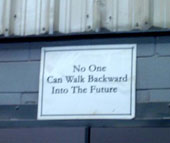 Interface is well on its way to the 2020 goal of complete sustainability and has on board vendors, suppliers, distributors, customers, and most importantly, a workforce united to achieve this milestone as a group effort. Through its worldwide operations and the insatiable dedication of its workers to pursue and promote innovation and creativity, the vision of complete sustainability is becoming a reality. It is now time for commerce and industry to begin its own mimicry by following “The Interface Model.”
Interface is well on its way to the 2020 goal of complete sustainability and has on board vendors, suppliers, distributors, customers, and most importantly, a workforce united to achieve this milestone as a group effort. Through its worldwide operations and the insatiable dedication of its workers to pursue and promote innovation and creativity, the vision of complete sustainability is becoming a reality. It is now time for commerce and industry to begin its own mimicry by following “The Interface Model.”
